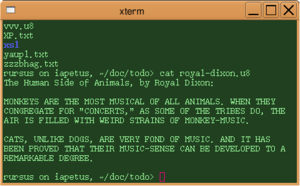Plain text
Plain text, is a loose term for data that represent only characters of readable material but not its graphical representation nor other objects (floating-point numbers, images, etc.).
In contrast to rich text, its representation does not come from its file format (such as language, font size, colours and hyperlinks), but instead, plain-text files often make use of markup languages or metadata to give structure, such as HTML, Markdown and XML, to name a few.
In contrast to binary files, it does not depend on portions being interpreted as binary objects (encoded integers, real numbers, images, etc.).
The use of plain text (rather than binary files) enables files to survive much better "in the wild", in part by making them largely immune to computer architecture incompatibilities. Plain text files can be opened, read, and edited with a wide range of text editors and utilities.
A common use of plain text is in command line interfaces, or CLI, through a terminal.
